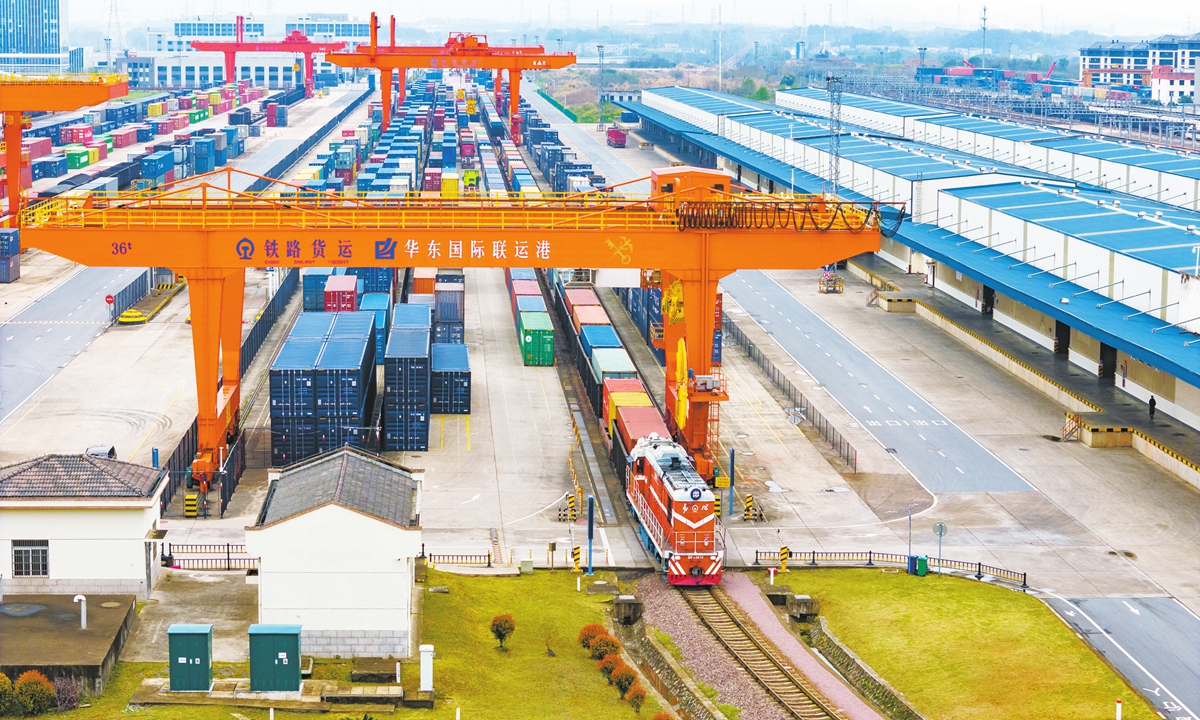
A train carrying 100 containers of goods departs the Jinhua South Railway Station in East China's Zhejiang Province for Kazakhstan, Uzbekistan, and other Central Asian countries, on March 31, 2025. Photo: VCG
Recently, a freight train slowly entered the container hub of Aktau Port in Kazakhstan, marking two important milestones. First, the train carried the 100,000th container of the China-Europe Railway Express across the Caspian Sea. Second, and crucially, it marked the official operation of China's first logistics project on the Caspian Sea coast.
Then on Saturday, with the resounding sound of a train whistle, a special train loaded with 55 containers departed Wujiashan Station in Wuhan, Central China's Hubei Province, for Uzbekistan, as the China-Central Asia train service opens up a new water-rail transport channel.
Meanwhile, at the Horgos Port in Northwest China's Xinjiang Uygur Autonomous Region, Chinese new-energy vehicles (NEVs) passed through one after another even at night, heading for the Central Asian market and beyond.
Together, these scenes paint a picture of ever-closer connectivity and constantly expanding cooperation in areas such as new energy between China and Central Asia. As the second China-Central Asia Summit is scheduled to kick off on Tuesday in Astana, Kazakhstan, these developments also highlighted the robust momentum and vast potential for further cooperation, an expert noted.
Greater connectivityThe Port of Aktau offered one of many examples of greater connectivity between China and Central Asia. It is China's first logistics project on the shores of the Caspian Sea and is tasked with storage and handling of containers used by the China-Europe Railway Express, according to an article posted on the website of the State-owned Assets Supervision and Administration Commission of the State Council (SASAC) on Monday.
As a key node of the over 7,000-kilometer land-sea transport corridor connecting the Pacific Ocean and the Caspian Sea, the Aktau Port Container Hub will become a modern "gas station" and "dispatching station" for the China-Europe Express' trans-Caspian Sea transportation, the SASAC article said.
The hub, which covers an area of 19 hectares, has a designed capacity to handle 240,000 containers a year and its first phase project has three rail lines for loading and unloading of cargo. Port of Lianyungang in East China's Jiangsu Province jointly built the program with the national railway company of Kazakhstan, according to the SASAC article.
"At a critical time when the global logistics landscape is undergoing a profound transformation and international cargo flows are being redistributed at an accelerated pace, the opening of the Aktau Port Container Hub, as the core node in the construction of the new Asia-Europe land-sea transport corridor, is very timely," read a statement the Port of Lianyungang sent to the Global Times.
The Central Asia train service from Wuhan has also seen robust growth. The special train that departed Wujiashan Station on Saturday carried 10 forty-foot containers filled with hot-melt adhesive - a relatively scarce building material in Central Asia, according to a report published on the official website of Hubei Provincial government on Monday.
These goods were first shipped from Taicang, Jiangsu, along the Yangtze River to Wuhan, and transferred from water to rail onto the Central Asia-bound train operated by Hubei Railway Group, the report said.
"Since the scheduled route of the Central Asia train (Wuhan) was approved in April this year, with one regular service each week, every train has carried goods transferred via the water-to-rail route, accounting for about one-fifth of the total cargo," said Wang Ziye, business manager of an international intermodal company under Hubei Railway Group.
With greater connectivity comes robust trade. According to data released by the General Administration of Customs (GAC) on Sunday, China's trade with the five Central Asian countries grew from 312.04 billion yuan in 2013 to 674.15 billion yuan in 2024, an increase of 116 percent.
In the first five months of this year, China's trade with the five Central Asian countries reached 286.42 billion yuan, up 10.4 percent year-on-year, setting a new record for the same period, according to the GAC.
Sustainable developmentThe growing connectivity not only boosts trade between China and Central Asia but also promotes sustainable development in regional countries, as green transformation becomes a key area of cooperation.
This is reflected in the 24-hour clearance operations at the Horgos Port. As the largest land port for automobile exports in China, the port has implemented a 24-hour clearance system, working seven days a week, to enhance trade logistics. According to statistics from Horgos Customs, the port had exported about 421,000 vehicles in 2024, reaching a new record high. From the Horgos Port, Chinese NEVs are transported to cities in Kazakhstan, Central Asian countries, and other countries and regions, according to Xinhua.
Liu Huayan, a manager of Xinjiang Hongyunda Freight International Co, has been engaged in cross-border trade between China and Central Asian countries for many years. Over time, the range of products she handles has expanded from construction materials to machinery, primarily to meet the growing industrial demand in the region.
One area where she sees significant potential for further growth is NEVs. Recently, she has been focusing more on this sector by increasing exports of NEV components, batteries, and complete vehicles to Central Asian countries, Liu said.
Yutong Bus Co, based in Zhengzhou, Central China's Henan Province, ranks among the largest suppliers of new-energy buses in Central Asia. By 2025, Yutong's total sales in the five Central Asian countries exceeded 10,000 units, including around 1,000 NEVs, according to a document the company sent to the Global Times on Sunday.
The company has also achieved significant results in localized cooperation, providing transportation services for over 2 million people annually in Kazakhstan and indirectly creating more than 5,000 jobs, it said.
In addition to NEVs, clean energy generation has also become a growth area of cooperation. The 60-MW Shelek Wind Farm in Kazakhstan, jointly invested and built by Power Construction Corporation of China (PowerChina) and Samruk-Energy Joint-Stock Company, represents a prime example.
As a flagship Belt and Road project, it was officially connected to the grid in July 2022. Currently, all 24 wind turbines are operating stably, generating solid economic returns. The project has significantly enhanced the reliability and independence of the power grid in the Almaty Region, reducing carbon dioxide emissions by over 160,000 tons annually, PowerChina said in a statement sent to the Global Times on Monday.
Expanding cooperation in industries such as green energy highlights China's significant role in promoting deeper regional cooperation, Zhang Hong, a senior research fellow at the Institute of Russian, Eastern European and Central Asian Studies of the Chinese Academy of Social Sciences, told the Global Times on Monday.
Looking ahead, amid a global rise in unilateralism, the partnership between China and Central Asia serves as a model of openness and mutual benefit, setting a positive example for regional collaboration, Zhang said, adding that the upcoming summit is expected to inject fresh momentum into China-Central Asia cooperation.




